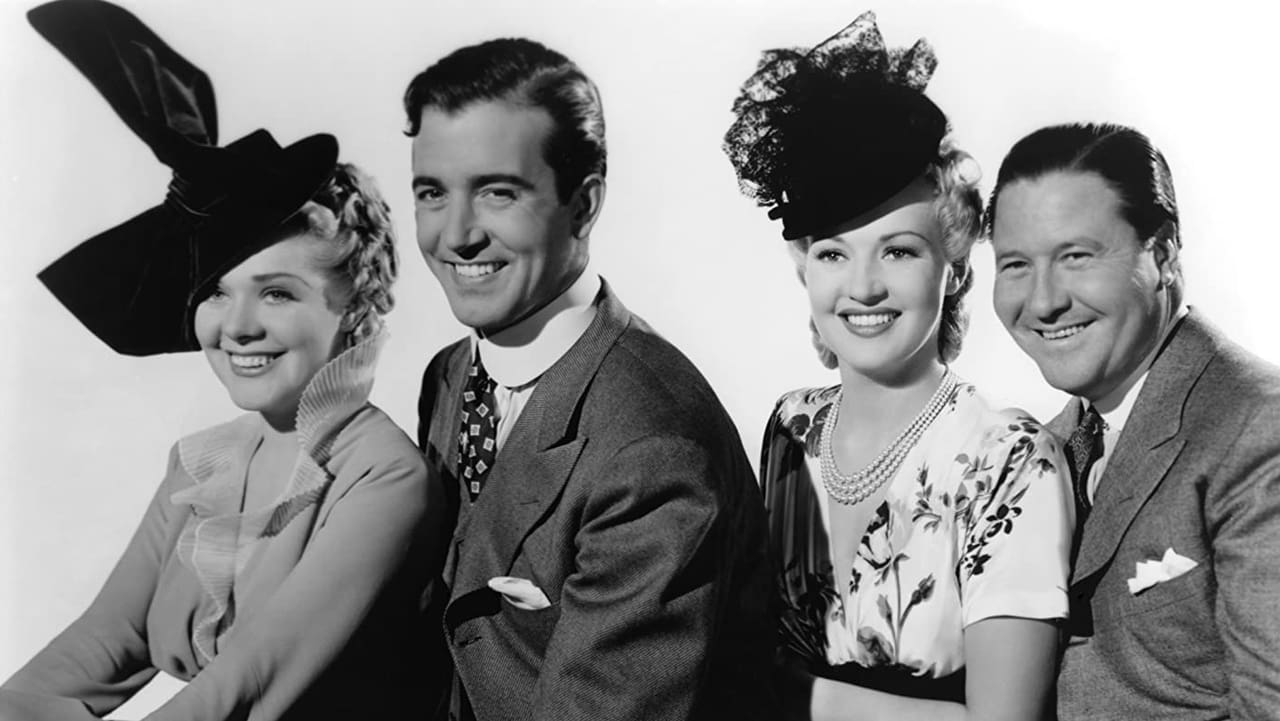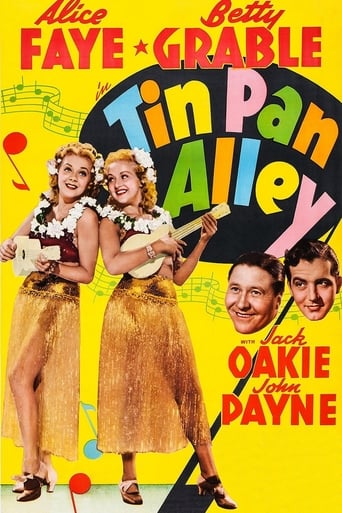



Good start, but then it gets ruined
Amazing worth wacthing. So good. Biased but well made with many good points.
View MoreThis is a gorgeous movie made by a gorgeous spirit.
View MoreThe film's masterful storytelling did its job. The message was clear. No need to overdo.
View MoreCopyright 29 November 1940 by 20th Century-Fox Film Corp. New York opening at the Roxy: 21 November 1940. U.S. release: 29 November 1940. Australian release: 17 April 1941. Original length: 9,000 feet, 100 minutes. Cut to 8,757 feet (97 minutes) in Australia and to 92 minutes in U.S.A. by deleting a song number, "Get Out and Get Under", featuring Faye, Grable and Oakie.SYNOPSIS: 1915-1919. Rags to riches to rags and back story of a couple of song publishers, one of whom is dumb (and greedy) enough not to realize Alice Faye is a loyal, sensitive girl who's in love with him.NOTES: Tin Pan Alley originally went into production in Technicolor. About half the film was photographed in color (approximately the first half, although there are a couple of later sequences in which the grainy lighting and too-thick make-up indicate original color cinematography) before the process was abandoned. Why is a good question. Two reasons: (1) The Sheik of Araby number ran into censor difficulties ("too much showgirl") and had to be re-shot. It certainly looks less daring in black-and-white. (Perhaps the Nicholas Brothers and Princess Ammon were also added at this stage to give the number "class"); (2) Zanuck felt that Technicolor flattered Grable at Faye's expense. Alice had made her color debut in Hollywood Cavalcade in which she looked great but had no competition. Immediately Tin Pan Alley was in the can, Zanuck rushed Alice into That Night in Rio, her second Technicolor feature, this time with a safe co-star - Carmen Miranda.Alfred Newman won an Academy Award for Best Score. This was the film's only nomination. Because of the color/black-and-white compromise, photography and art direction were ineligible for nomination, but it is strange that "You Say the Sweetest Things, Baby" was not proposed for Best Song. It's not only the first song Harry Warren and Mack Gordon wrote for Alice (it remained her personal favorite of all her numbers) but it's given such a stand-out treatment with such an elaborate musical reprise, I can't figure how any nominator could possibly miss it.The film was remade in 1950 as I'll Get By, with June Haver and William Lundigan directed by Richard Sale.COMMENT: There has to be a higher rating than 100% for this movie. Alice of course dominates the film but she is not allowed to completely overshadow the rest of the cast - as some critics have claimed. True, the script has John Payne elbowing Betty Grable aside to give Alice a shot at "Moonlight Bay", but Betty is by no means neglected. Although she has no romantic steady, she has a couple of solo production numbers as well as joining Alice for "Hawaii" and the movie's delightfully zesty showpiece, "The Sheik of Araby".Comedian Jack Oakie has a regal share of the limelight too, while Payne has if anything even more footage. And there's a grand supporting roster including Allen Jenkins, Elisha Cook and Charles Wilson (all of whom have some delightful running gags), not to mention Esther Ralston, Billy Gilbert, the Nicholas Brothers and Billy Bevan who are also given their opportunities to shine.It's to Alice's credit that she's so electrifying we still pine when she's off-screen (which is really quite often), especially during the straight Payne episodes. Fortunately the songs are an incomparably breezy lot - and they are given a marvelously aggressive orchestration and often an all-stops-out treatment with elaborate reprises and thrilling montages. The sound of course is absolutely dazzling.Walter Lang's pacey direction makes the most of the picture's superb production values. No expense whatever has been spared on lavish sets and crowd scenes. And what about those incredible period costumes that Alice and Betty fill so gracefully? All told, marvelous entertainment with catchy songs, amusing business and a power-plus cast. Hollywood zest at its best!
View MoreAlice Faye and Betty Grable were made for each other as a sister act, together or separately. As the dominant sister, Alice got most of the single numbers, but Betty got to show her stuff in the "Honeysuckle Rose"- "Moonlight and Roses" routine. I can't believe they were never paired again(Well, they were supposed to be in "The Dolly Sisters", but it was too late, as Alice decided to retire just then). John Payne and Jack Oakie were another great buddy pair, Oakie providing a perfect comic balance to Payne's serious demeanor, as a pair of struggling tune smiths. Oakie does an impromptu rendition of a classic George M. Cohan war moral booster, composed about the time this story takes place, at the beginning of WWI. This duo would appear together or separately in several more Faye films. Payne would also serve as a usually successful rival for Betty's heart in several other films. Too bad Oakie was never considered romantic material for the leading ladies. He was certainly charming enough. He could have teamed up with Betty while Payne was romancing or sulking with Alice.The Nicholas Brothers were yet another talented pair, though they only appeared in their dance routine in "The Sheik of Araby" extravaganza. Breaking the color barrier, they appeared in a number of top musicals of this era, including "Sun Valley Serenade" and the all African American cast in "Stormy Weather", where they performed perhaps their most famous routine. Rotund veteran comedian Billy Gilbert seemed bored with his harem and other diversions, until Alice and Betty showed up in his harem, when he joined them in a memorable song and dance rendition of the title song for "The Sheik of Araby" scene. All in all, a great vaudevillian mix of song and dance, comedy and romantic drama. My main regret is that this wasn't filmed in Technicolor. Few films were then, and the studios didn't always pick the right ones for this luxury treatment. It's about time a DVD version of this classic musical comedy was made available, and dare I hope for a colorized version?This film was essentially remade in 1949as "Oh, You Beautiful Doll", in Technicolor. June Haver and Gail Robbins took the places of Alice and Betty. Mark Stevens and S.Z. Sakal took the places of Payne and Oakie, respectively. I like the original better, except it was filmed in B&W.
View More"All good-lookin' like he is, there's no use in getting' yourself all messed up", a black boy ponders, when 'Skeets' Harrigan (John Payne) drops out of a promising boxing career to pursue his dreams of becoming a renowned Tin Pan Alley song publisher with his friend from the Midwest, Harry Calhoun (Jack Oakie). On their way to the top they meet the Blane sisters, Katie (Alice Faye) and Lily (Betty Grable). 'Skeets' and Katie fall in love, but he is adamantly focused on his career and when he gives a song meant for Katie to a famous musical star, she has had it and leaves for London with her sister. That is when World War I erupts ...'Tin Pan Alley' has more charm than it has plot, and it's a delightful watch with charismatic actors. Faye and Grable are a wonderful pair of tap-dancing sisters, Oakie is genuinely funny as the befuddled average Joe playing at being a tough guy, and John Payne, a Robert Taylor look-alike, clearly in a role that must have been written for typical Faye co-star Tyrone Power, rises to the occasion and delivers his all, a perfect mix of athletic hunkiness and crooning abilities, not the easiest performance to pull of, as 'Skeets' is quite callous in the way he presses forward.The film abounds with great music and showpieces, 'Honeysuckle Rose' in Faye's very nice rendition with a boy chorus, 'The Sheik of Araby' featuring glorious tap-dancing by The Nicholas Brothers, the rousing "America, I Love You", and the only song actually written for the film, Harry Warren's 'You Say the Sweetest Things (Baby)", utilized to the fullest in a clever montage.
View MoreThis is a delightful film with some of the best stars from the 40's. Alice Faye has been a personal favorite of mine for years and her beautiful contralto singing voice is only one reason. She is also charming and beautiful, and it's no wonder she was 20th Century Fox's top blonde star for many years (until Betty Grable, who is, of course, also in this film). Alice and Betty make believable sisters and perform some knockout numbers together (especially "The Sheik of Araby", which also boasts the talents of the marvelous Nicholas Brothers). Alice is paired romantically in the film with John Payne (a frequent costar), and their chemistry makes you understand why Fox paired them often in film. The songs are delightful and the movie captures the image of Tin Pan Alley that may not have existed in reality, but isn't the image on film more romantic and lovely to look at? The only quibble I have: why, oh why wasn't this filmed in Technicolor?
View More